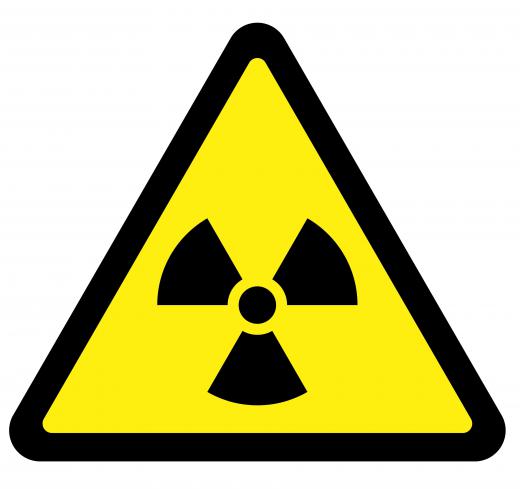What is Alpha Decay?
 Mary McMahon
Mary McMahon
Alpha decay is a form of radioactive decay in which an alpha particle is emitted by a heavy element in an attempt to become more stable. The other types of radioactive decay are beta decay and gamma decay. Particle detectors can be used to detect the emission of alpha particles, and the process of alpha decay can also be used to build detection devices. Some fire detectors, for example, rely on the steady rate of alpha decay to ionize air, which can in turn detect smoke when smoke particles interfere with the conductivity of the ionized air.
The components of a nucleus consist of protons and neutrons orbited by a group of electrons. Under normal conditions, these particles would oppose each other, causing the nucleus to fall apart, which is where something known as the strong nuclear force comes in. The strong nuclear force keeps the nucleus together, preventing particles from being forced out. However, although this force is strong, it has a narrow range, and in the case of a large nucleus, it may not be able to contain all of the particles. As a result, the atom becomes unstable, and it starts to emit particles, in a process known as radioactivity.

In the case of alpha decay, the particle consists of two protons and two neutrons tightly bound together. This particle happens to be identical in structure to the nucleus of a helium atom, and much of the Earth's supply of helium actually comes from alpha decay. As the alpha particle leaves the atom, taking protons and neutrons with it, the atomic number changes, and the atom becomes a new, more stable element. The loss of mass is converted into a small burst of energy.

Alpha particles are extremely weak. They can be stopped with a piece of paper or even a small air pocket, making alpha decay relatively non-threatening for people who work around it. However, if an element which emits alpha particles is ingested, this can cause a serious problem. Radon gas, for example, can be inhaled into the lungs, where the alpha particles emitted by the gas can cause serious damage to the delicate cells which line the lungs.
The toxicity of alpha decay inside the body has been suspected in several high profile poisonings. By introducing elements which emit alpha particles to food, a poisoner can successfully kill someone without causing problems in people in the surrounding environment. Death by alpha decay seems to be particularly popular among Russian spies, although other clandestine agents have been known to employ it on occasion.
AS FEATURED ON:
AS FEATURED ON:












Discussion Comments
where do the two electrons go when the alpha particle decays from the uranium nucleus?
Post your comments